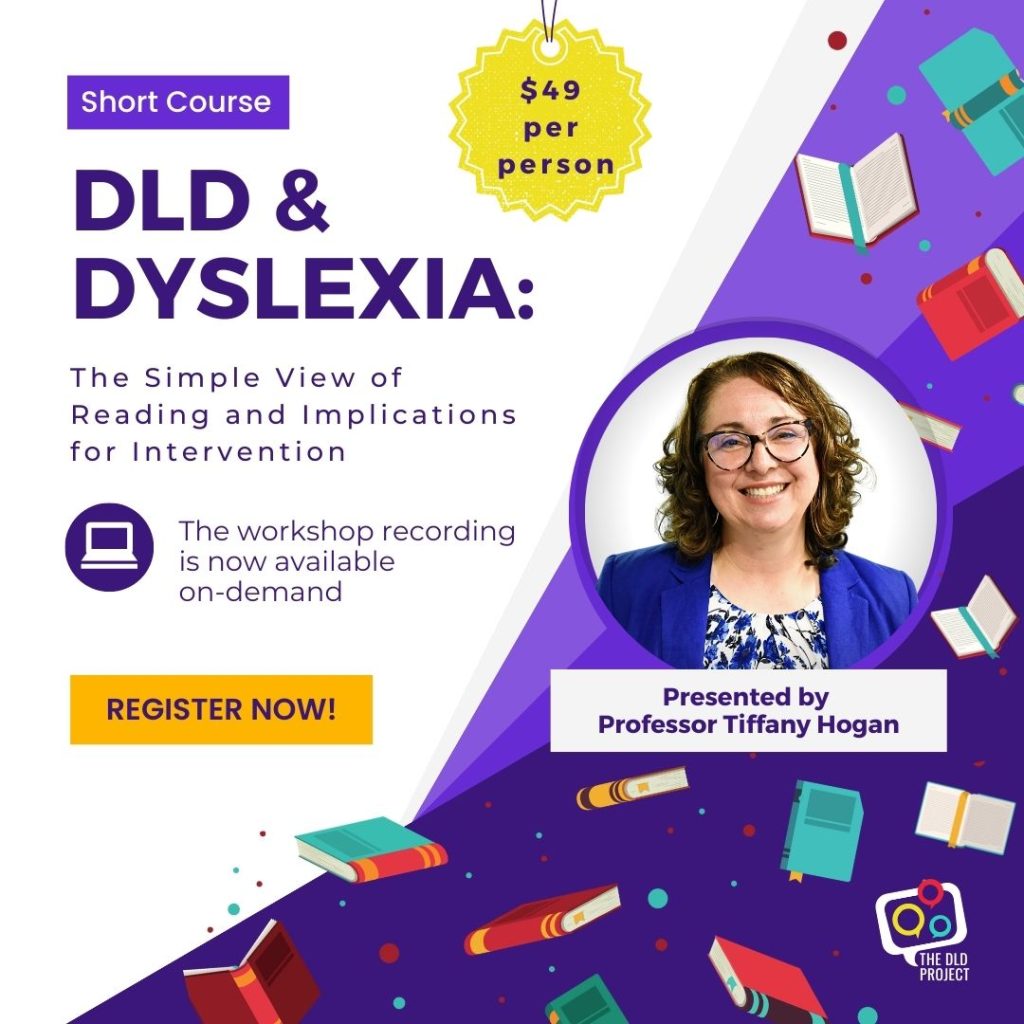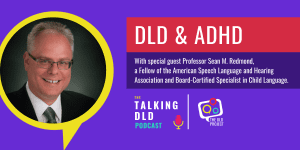Language is a fundamental aspect of human communication and interaction. However, for some individuals, language development doesn’t unfold as expected, leading to challenges in communication, reading, and writing. Developmental Language Disorder (DLD) and Dyslexia are two such conditions that significantly impact an individual’s ability to use language effectively. In this blog, we delve into the intricacies of DLD and Dyslexia, exploring their characteristics, causes, and potential interventions, drawing insights from recent research in the field.
Table of Contents
Learn more about DLD and Dyslexia with Professor Tiffany Hogan
Professor Tiffany Hogan’s research stands as a beacon, illuminating the complexities of conditions like Developmental Language Disorder (DLD) and Dyslexia. Through her pioneering work, Hogan has contributed significantly to our understanding of these disorders, unraveling their mysteries and paving the way for innovative interventions. You can learn more about DLD & Dyslexia by completing our short course with Professor Hogan.
Understanding Developmental Language Disorder (DLD)
Developmental Language Disorder (DLD) is a neurodevelopmental condition characterised by difficulties in understanding and/or using spoken language, which persist over time and are not attributed to other developmental disabilities, sensory impairments, or neurological conditions. Individuals with DLD may struggle with vocabulary development, grammar, and comprehension, leading to challenges in communication and academic achievement.
Research studies have shed light on various aspects of DLD, including its prevalence, underlying mechanisms, and potential risk factors. For instance, a study by Bishop et al. (2017) found that approximately 7% of children aged 5-17 years met the criteria for DLD, highlighting the significance of this condition in pediatric populations. Furthermore, neuroimaging studies have identified differences in brain structure and function in individuals with DLD, suggesting a neurobiological basis for the disorder (Leonard et al., 2006).
Exploring Dyslexia
Dyslexia is a specific learning disorder that primarily affects reading acquisition despite adequate intelligence, educational opportunities, and socio-cultural background. Individuals with dyslexia may experience difficulties with accurate and/or fluent word recognition, poor spelling, and decoding abilities. Dyslexia is not solely a visual problem but involves difficulties in processing language at the phonological level.
Recent research has provided valuable insights into the underlying causes of Dyslexia, highlighting the role of genetic factors, neurobiological differences, and environmental influences. For example, a study by Gialluisi et al. (2019) identified several genetic variants associated with Dyslexia risk, providing evidence for the genetic basis of the disorder. Additionally, neuroimaging studies have revealed differences in brain activation patterns during reading tasks in individuals with Dyslexia, implicating disruptions in the neural circuits involved in phonological processing (Saygin et al., 2013).
By employing behavioural assessments, eye-tracking technology, and neuroimaging methods, Professor Hogan has unpacked the neurocognitive profiles of individuals with Dyslexia, paving the way for targeted interventions aimed at improving reading fluency and comprehension.
Signs of Developmental Language Disorder (DLD)
- Delayed Language Milestones: Children with DLD may exhibit delays in reaching language milestones, such as babbling, speaking first words, and forming complex sentences.
- Limited Vocabulary: A restricted vocabulary is a hallmark of DLD. Children may struggle to learn new words and have difficulty recalling and using words appropriately in conversation.
- Grammar Difficulties: Children with DLD often have challenges with grammar, including verb tense, sentence structure, and pronoun use. They may produce simplified or telegraphic speech.
- Poor Comprehension: Difficulty understanding spoken language is common in individuals with DLD. They may struggle to follow instructions, comprehend stories, or infer meaning from context.
- Social Communication Problems: DLD can impact social communication skills, leading to difficulties in initiating and maintaining conversations, understanding nonverbal cues, and participating in social interactions.
- Persistent Speech Sound Errors: Some children with DLD may exhibit persistent speech sound errors beyond the typical age of acquisition, affecting their intelligibility.
- Difficulty with Word Retrieval: Individuals with DLD may experience word-finding difficulties, struggling to retrieve words from memory when speaking or writing.
Signs of Dyslexia
- Reading Difficulties: Dyslexia primarily affects reading acquisition, leading to difficulties with accurate and fluent word recognition, decoding, and reading comprehension.
- Slow Reading Rate: Individuals with dyslexia may read slowly and laboriously, struggling to recognise words quickly and efficiently.
- Poor Spelling: Dyslexia often co-occurs with difficulties in spelling, as individuals may have trouble mapping sounds to letters and spelling words phonetically.
- Reversals and Substitutions: Letter reversals (e.g., confusing b and d) and substitutions (e.g., reading “cat” as “bat”) are common errors in individuals with dyslexia.
- Difficulty with Phonological Awareness: Phonological awareness refers to the ability to recognise and manipulate the sounds of language. Individuals with Dyslexia may struggle with tasks involving phonological awareness, such as rhyming, segmenting, and blending sounds.
- Poor Writing Skills: Dyslexia can impact writing skills, including handwriting legibility, organisation of ideas, and grammatical accuracy.
- Family History: Dyslexia often runs in families, suggesting a genetic component to the disorder. A family history of reading difficulties may increase the likelihood of Dyslexia in an individual.
Signs of Co-Occurring DLD & Dyslexia
When DLD and dyslexia co-occur, the signs and symptoms of each disorder may overlap, making diagnosis and intervention more challenging. Some common signs of co-occurring DLD and Dyslexia include:
- Severe Reading Difficulties: Individuals with co-occurring DLD and Dyslexia may exhibit more pronounced reading difficulties than would be expected based on their cognitive abilities alone.
- Language-Based Reading Comprehension Problems: Difficulties in understanding written text, particularly comprehension of complex sentences and inferential reasoning, may be evident.
- Persistent Language Difficulties: Even with targeted reading interventions, individuals with co-occurring DLD and Dyslexia may continue to experience significant challenges with language comprehension, production, and social communication.
- Phonological Processing Deficits: Deficits in phonological processing, such as difficulties with phonemic awareness and phonological memory, are common in individuals with co-occurring DLD and Dyslexia.
- Educational Implications: Co-occurring DLD and Dyslexia can have profound implications for academic achievement, requiring comprehensive interventions that address both language and literacy difficulties.
DLD and Dyslexia Overlap and Distinctions
While DLD and Dyslexia are distinct conditions, there is often overlap in their symptoms and underlying difficulties. Both conditions involve challenges in language processing, particularly at the phonological level, which can impact reading and writing abilities. However, individuals with DLD typically exhibit broader impairments in language comprehension and production, whereas dyslexia primarily affects reading-related skills.
Intervention and Support for DLD and Dyslexia
Early identification and intervention are crucial for supporting individuals with DLD and Dyslexia. Speech-language therapy, specialised literacy instruction, and assistive technologies can help address specific difficulties and promote language and literacy development. Furthermore, a multi-disciplinary approach involving educators, speech pathologists, psychologists, and other professionals is essential for providing comprehensive support tailored to the individual’s needs.
Conclusion
Developmental Language Disorder (DLD) and Dyslexia are complex neurodevelopmental conditions that impact language and literacy skills, posing challenges for affected individuals. However, ongoing research efforts are unraveling the mysteries surrounding these disorders, providing valuable insights into their underlying mechanisms and potential interventions.
By raising awareness, promoting early identification, and offering targeted support, we can empower individuals with DLD and Dyslexia to reach their full potential in communication, education, and life.
References
- Bishop, D. V. M., Snowling, M. J., Thompson, P. A., Greenhalgh, T., & CATALISE consortium. (2017). CATALISE: A Multinational and Multidisciplinary Delphi Consensus Study. Identifying Language Impairments in Children. PLOS ONE, 12(6), e0179651.
- Leonard, L. B., Ellis Weismer, S., Miller, C. A., Francis, D. J., Tomblin, J. B., & Kail, R. V. (2006). Speed of processing, working memory, and language impairment in children. Journal of Speech, Language, and Hearing Research, 49(5), 970–993.
- Gialluisi, A., Andlauer, T. F. M., Mirza-Schreiber, N., Moll, K., Becker, J., Hoffmann, P., Ludwig, K. U., Czamara, D., St Pourcain, B., Brandler, W., Honbolygó, F., Tóth, D., Csépe, V., Huguet, G., Morris, A. P., Hulslander, J., Willcutt, E. G., DeFries, J. C., Olson, R. K., … Paracchini, S. (2019). Genome-wide association scan identifies new variants associated with a cognitive predictor of dyslexia. Translational Psychiatry, 9(1), 77.
- Saygin, Z. M., Norton, E. S., Osher, D. E., Beach, S. D., Cyr, A. B., Ozernov-Palchik, O., & Gabrieli, J. D. E. (2013). Tracking the Roots of Reading Ability: White Matter Volume and Integrity Correlate with Phonological Awareness in Prereading and Early-Reading Kindergarten Children. The Journal of Neuroscience, 33(33), 13251–13258.
- Hogan, T. P., Adlof, S. M., & Alonzo, C. N. (2014). On the importance of the simple view of reading for the identification of reading disabilities. Journal of Learning Disabilities, 47(5), 393–404.
- Hogan, T. P., & Catts, H. W. (2010). The relationship between phonological awareness and reading: Implications for the assessment of phonological awareness. Language, Speech, and Hearing Services in Schools, 41(3), 287–293.
- Hogan, T. P., & Shipley, K. G. (2018). The impact of reading instruction on the neural correlates of phonological processing in developmental dyslexia: A longitudinal fMRI study. Brain Imaging and Behavior, 12(4), 1110–1125.





